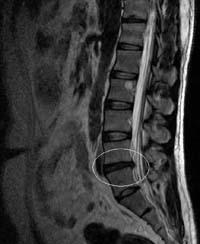
Image via Wikipedia
Lower back pain presents in a range of severity depending on the structures generating the pain.
A simple sprain/strain can still cause extreme pain, swelling, and immobilization for a couple of days but should completely resolve after a few weeks with proper care and rest. Lumbar sprain/strains are associated with lifting something heavy, or even simply bending or twisting at the waist; weight lifting, sports injuries and trauma like a car accident. By definition, they are limited to injury to the muscles, fascia, tendons and ligaments. The pain is limited to the area of injury.

Image via Wikipedia
A lumbar disc bulge occurs when a disc “bulges” outwards due to weakness or injury. A disc is a tough, fibrous ligament that holds the lumbar vertebrae together at the vertebral body. The disc’s outer periphery, called the annulus, resembles a slice of an onion, with multiple rings of fibrous tissue encasing a jelly-like material called the nucleus pulposus. While tough and strong, it allows movement of the individual vertebrae.
By definition, a disc bulge is still intact and has not ruptured (as opposed to a disc herniation or rupture). The bulge represents a weakened area in the annulus that allows the nucleus to gravitate towards a section of the periphery, usually the posterior (rear-facing) edge, facing the spinal canal (where nerve tissue is present). It can be a broad-based bulge, or a more focal bulge. If it is greater than 5mm (measured from the edge of the vertebral body to the tip of the bulge) it is clinically significant. Many people have disc bulges and have no back pain at all; in fact, it is normal for the discs to bulge slightly in the weight bearing position (standing).
The problem occurs when the bulge contacts nerve structures. If large enough, they can contact the thecal sac (contains the spinal cord and cauda equina) by bulging backwards into the canal, and they can press on spinal nerve roots by bulging to the sides. The spinal nerve roots branch out in pairs from either side and exit holes formed between adjacent vertebrae called vertebral foramen, or lateral canals. A disc bulging to the posterior and side can narrow this opening and pinch the nerve root causing pain to travel down the buttock or leg, depending on which nerve root.
TREATMENT:
If your lower back pain is felt deep, and you can make it hurt more by bending your lower back backwards and to the side, you may have a disc bulge. You may or may not have pain and/or numbness going down the buttock and leg (same side of the pain). If it happened while lifting something heavy, the diagnosis is more likely. If you have extreme, unchanging pain with more constant leg pain or paresthesias (numbness, tingling) that does not get better with ice and rest, you may have a disc rupture (also called prolapse) where the inner nucleus had broken through the annulus and is in the spinal canal or lateral canal. If you have changes in your gait (walk) such as foot drop, weakness in your legs, difficulty walking upstairs, then the diagnosis of disc prolapse is more probable.
Disc bulges can be managed with conservative treatment like home care, chiropractic, and physical therapy. Disc prolapses should be evaluated by an orthopedic surgeon or neurosurgeon. An MRI should be ordered to evaluate the extent of the injury.
If you suspect you have a disc bulge, take care not to aggravate it. No heavy lifting, no jumping activities (basketball, badminton– anything where your feet leave the floor and land hard).
Discs usually bulge backwards (posterior), so do movements that encourage the bulge to move back to center. Lie on your back and bring both knees to your chest (ok to use your arms to grab your knees while they are bent, and pull and hold to your chest). This will put your lumbar spine in flexion, or a nice convex curl. Your back contour should be like that of an egg, and you should be able to rock back and forth. Maintain the pull, stretching your lower back into this curve. Hold for 30 seconds, then slowly extend your legs on the floor and rest for 15 seconds (optional: put a frozen ice gel pack covered with a kitchen towlette under your lower back during this exercise). Repeat six times. This will have the effect of creating separation between the posterior ends of the lumbar vertebrae, helping to reduce the bulge.
Next, stand and place your hands on your hips, and slowly arch your back backwards, putting your lumbar spine into extension— the opposite curvature as the previous exercise. Bend back until you can’t anymore, but don’t over do it. Hold this position for six seconds, then return to neutral. Repeat eight times. This will have the effect of bringing the posterior ends of the lumbar vertebrae closer together and pushing the nucleus back towards the center.
Do the above series of exercises three-four times a day for a week until the discomfort is gone. At this point, you should focus on doing things to strengthen the disc. Eating a wholesome, healthy diet with enough protein, fat and plant material will help; avoiding destructive activities like smoking, alcohol, and staying up late will enable optimum conditions for tissue healing. Gradually start doing exercises that improve lower back muscle conditioning and coordination.
Getting a series of 6-8 chiropractic adjustments to the lumbar spine may also be helpful in reducing your bulging disc.








